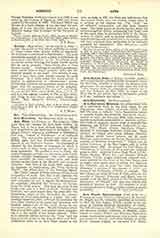

Acta Pilati (or GOSPEL OF NICODEMUS).—This work does not assume to have been written by Pilate, but to have been derived from the official Acts preserved in the praetorium at Jerusalem. The alleged Hebrew original is attributed to Nicodemus. The title “Gospel of Nicodemus” is of medieval origin. The apocryphon gained wide credit in the Middle Ages, and has considerably affected the legends of our Savior’s Passion. Its popularity is attested by the number of languages in which it exists, each of these being represented by two or more recensions. We possess a text in Greek, the original language; a Coptic, an Armenian, and a Latin, besides modern translations. The Latin versions were naturally its most current form and were printed several times in the fifteenth and sixteenth centuries. One class of the Latin MSS. contain as an appendix or continuation, the “Cura Sanitatis Tiberii”, the oldest form of the Veronica legend.
The “Acta” consist of three sections, which reveal inequalities of style. The first (i—xi) contains the trial of Jesus, based upon Luke, xxiii. The second part comprises xii—xvi; it regards the Resurrection. An appendix, detailing the Descensus ad Inferos, forms the third section. This does not exist in the Greek text and is a later addition. Leucius and Charinus, two souls raised from the dead after the Crucifixion, relate to the Sanhedrin the circumstances of Our Lord’s descent to Limbo. The well-informed Eusebius (325), although he mentions the Acta Pilati referred to by Justin and Tertullian, and heathen pseudo-Acts of this kind, shows no acquaintance with this work. We are forced to admit that it is of later origin, and scholars agree in assigning it to the middle of the fourth century. There is no internal relation between the “Acta” and the feigned letter found in the Acts of Peter and Paul. Epiphanius refers to an Acta Pilati similar to our own, as early as 376, but there are indications that the current Greek text, the earliest extant form, is a revision of the original one. The “Acta” are of orthodox composition and free from Gnostic taint. The book aimed at gratifying the desire for extra-evangelical details concerning Our Lord, and at the same time, to strengthen faith in the Resurrection of Christ, and at general edification. The writers (for the work as we have it is composite) could not have expected their production to be seriously accepted by unbelievers. (See Apocrypha, under Pilate Literature.)
GEORGE J. REID

